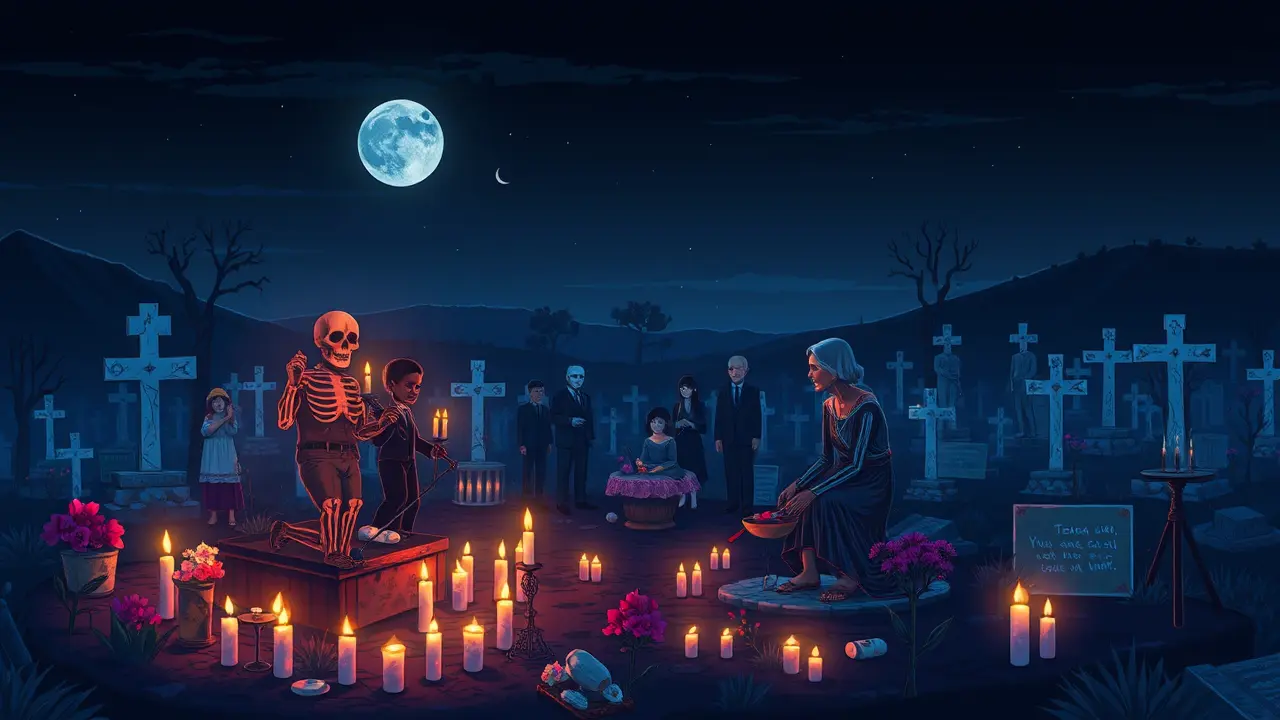
SciencearchaeologyCultural Heritage
Mexican Families Celebrate Day of the Dead in Candlelit Cemeteries.
LA
Laura Bennett
9 hours ago7 min read
In the small, lakeside town of Arocutin, nestled in the western Mexican state of Michoacán, the veil between worlds grows thin as night falls. This isn't a time for mourning; it's a grand, vibrant reunion.Families, from the eldest abuela to the smallest niño, gather in the local panteón, transforming the cemetery from a place of solemn silence into a living, breathing space of memory. They arrive with armfuls of bright orange cempasúchil flowers, their pungent, earthy scent believed to guide the spirits home.They carefully clean the tombstones of their ancestors, scrubbing away a year's worth of dust and weather, an act of devotion that is both tender and practical. Then come the offerings, the ofrendas, built right there at the gravesite—a breathtaking mosaic of love and remembrance.There are photographs in weathered frames, capturing a young man's smile or a grandmother's wise eyes. There are the favorite foods of the departed: a plate of tamales, a glass of potent tequila, a slice of sweet pan de muerto.They light countless velas, candles whose flames flicker and dance in the cool night air, each one a tiny beacon of welcome in the darkness, a signal to the souls that they are expected, they are remembered, they are still very much a part of the family. This is Día de los Muertos, the Day of the Dead, and to witness it is to understand a profound and beautiful truth about how we grapple with loss.I’ve spent years talking to people about their rituals, the small, daily acts that give life meaning, and nothing compares to the raw, communal honesty of this celebration. It’s a tradition that speaks to a deep, human need to keep our loved ones close, not as ghosts, but as active participants in our story.The roots of this practice run deep, a complex syncretism where ancient Indigenous beliefs, particularly from the Purépecha and Aztec cultures who saw death not as an end but as another stage of existence, collided with and were reshaped by the Catholic All Saints' and All Souls' Days brought by Spanish colonizers. The result is something uniquely Mexican, a cultural identity forged in the crucible of history and faith.An anthropologist I once interviewed in Pátzcuaro explained it as a form of ‘participatory memory,’ where the living actively construct a bridge to the past through sensory experience—the taste of the food, the smell of the marigolds, the visual spectacle of the candles. It’s a powerful counter-narrative to the modern, often sterile, way we handle death in many other parts of the world, where grief is a private matter to be processed quietly.Here, it is public, it is loud, it is colorful, and it is shared across generations. As one woman, her face illuminated by the candlelight as she arranged sugar skulls on her father's grave, told me, 'We are not scared of them.We miss them. So for one night, we invite them back to eat, to drink, to laugh with us again.It hurts a little less when you can still set a place for them at the table. ' This sentiment echoes through the cemetery, in the soft murmurs of families telling stories, in the laughter that occasionally rings out, in the quiet tears that are wiped away without shame. It’s a testament to the resilience of the human spirit, a way of looking mortality directly in the eye and responding not with fear, but with an open heart and a beautifully decorated altar.
#featured
#Day of the Dead
#Mexico
#tradition
#culture
#celebration
#Arocutin
#cemeteries
#indigenous beliefs
Stay Informed. Act Smarter.
Get weekly highlights, major headlines, and expert insights — then put your knowledge to work in our live prediction markets.
© 2025 Outpoll Service LTD. All rights reserved.